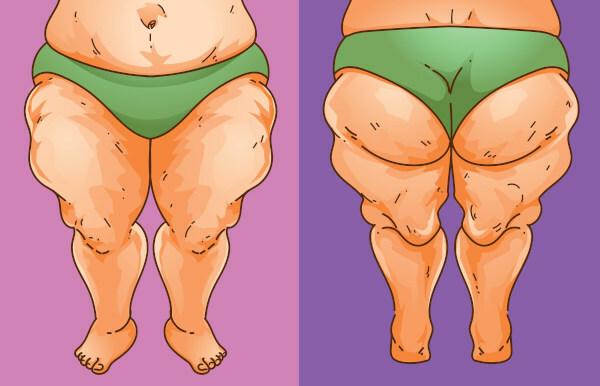O lipoedema It is a chronic and progressive disease in which an abnormal increase in fat can be observed, especially in the lower limbs. The disease, which usually affects women, has a hormonal component, and hereditary factors also seem to be involved in its development.
The disease can cause, in addition to the accumulation of fat, pain, the appearance of bruises, heaviness in the limbs and difficulty in locomotion. The diagnosis is clinical and often confused with obesity, but it is important to note that, in cases of obesity, the formation of nodules in the subcutaneous tissue is not observed. Treatment is based on changing lifestyle habits, using specific medications and, in some situations, liposuction.
Read too: Atherosclerosis — a disease caused by the accumulation of fat in the arteries
Topics of this article
- 1 - Summary about lipedema
- 2 - What is lipedema?
- 3 - Lipedema symptoms
- 4 - Stages of lipedema
- 5 - Diagnosis of lipedema
- 6 - Lipedema treatment
- 7 - Difference between lipedema and obesity
Lipedema summary
Lipedema is a chronic and progressive disease that causes the abnormal accumulation of fat, mainly in the legs and ankles.
It mainly affects women, and hormonal factors are related to the problem.
In addition to the accumulation of fat, the individual may experience pain, swelling, heaviness in the limbs, the appearance of bruises and fragility of the capillaries.
The disease can be classified into four stages, with stage four associated with impairment of the lymphatic system.
The diagnosis of the disease is clinical.
Treatment involves changes in diet, physical activity and even liposuction.
What is lipedema?

Lipedema it is a chronic disease and progressive hormonal in origin and it is often confused with obesity because it causes an abnormal accumulation of fat in the legs and ankles. Although the cause is still not well known, it is believed that hereditary factors are involved in the development of this disease.
Lipedema appears more frequently in females at the onset of puberty. Other phases of life in which it can arise are during pregnancy and menopause, situations in which there is great hormonal variation.
Do not stop now... There's more after the publicity ;)
lipedema symptoms
Lipedema is characterized by fat accumulation, mainly, in the region of the legs and ankles. The increase in fat in these regions causes a disproportion between the upper and lower parts of the body to occur and can hinder the individual's mobility. The accumulation of fat can also, in some situations, affect the arms. It does not occur in the hands, feet and trunk region.
O individual with lipedema can present yet:
pain;
swelling;
heaviness in limbs;
appearance of bruises;
fragility of the capillaries (small caliber blood vessels).
stages of lipedema
According to the Brazilian Society of Angiology and Vascular Surgery – Regional São Paulo, we can observe four stages of the disease, namely:
Stage 1: the surface of the skin appears normal, with an increase in fat in the subcutaneous tissue and the presence of fat nodules, which resemble pearls, under the skin.
Stage 2: the skin, differently from stage 1, is irregular, flaccid and with the appearance of cellulite, and the nodules that we can palpate become larger.
Stage 3: the skin is even looser than in the previous stages, and folds are found in it. The patient has nodules and areas of fibrosis, which resemble scars, under the skin caused by chronic inflammation.
Stage 4: the patient has all the alterations of the patient in stage 3, in addition to the involvement of the lymphatic system.
Read too: Thrombophilia — the increased risk of developing thrombosis
Diagnosis of lipedema
Lipedema is a disease often confused with obesity, which means that it is not diagnosed quickly. O diagnosis is performed clinically, with the analysis of the deposition of fat in the patient's body and the other associated symptoms. Although the diagnosis is essentially clinical, exams such as computed tomography, magnetic resonance imaging and ultrasound can help close the diagnosis of the disease.
lipedema treatment
As noted, lipedema is a chronic disease, however, there is treatment that can soften thes patient's symptoms, guaranteeing a better quality of life. Among the measures adopted, we can highlight the change in diet, the adoption of exercise practices physiques, the use of some medications and even surgery, a liposuction that is different from the conventional one.
We must also mention that patients with lipedema may have psychological problems, since their physical appearance and mobility difficulties may negatively affect them. Psychological follow-up is therefore essential.
Difference between lipedema and obesity
Many people believe that the accumulation of fat in lipedema is, in reality, obesity, a doubt that can delay the diagnosis. According to the Brazilian Society of Angiology and Vascular Surgery – Regional São Paulo, the fat observed in cases of lipedema differs from that observed in cases of obesity, as it tends to form nodules in the subcutaneous tissue, in addition to having an inflammatory component important. To learn more about obesity, click here.
By Vanessa Sardinha dos Santos
Biology teacher
Would you like to reference this text in a school or academic work? Look:
SANTOS, Vanessa Sardinha dos. "Lipedema"; Brazil School. Available in: https://brasilescola.uol.com.br/doencas/lipedema.htm. Accessed May 11, 2023.
Learn more about obesity, and understand why it is necessary to fight this health problem that is now considered a worldwide epidemic.
Know which are the layers that form the skin.
Understand what puberty is and find out what changes occur in the bodies of girls and boys during this important phase.
Click here and learn more about adipose tissue, which is rich in lipids. In this text we will know the characteristics, types and function of this fabric!
Ufes launched this morning, May 10, the free course platform Moocqueca. You...


